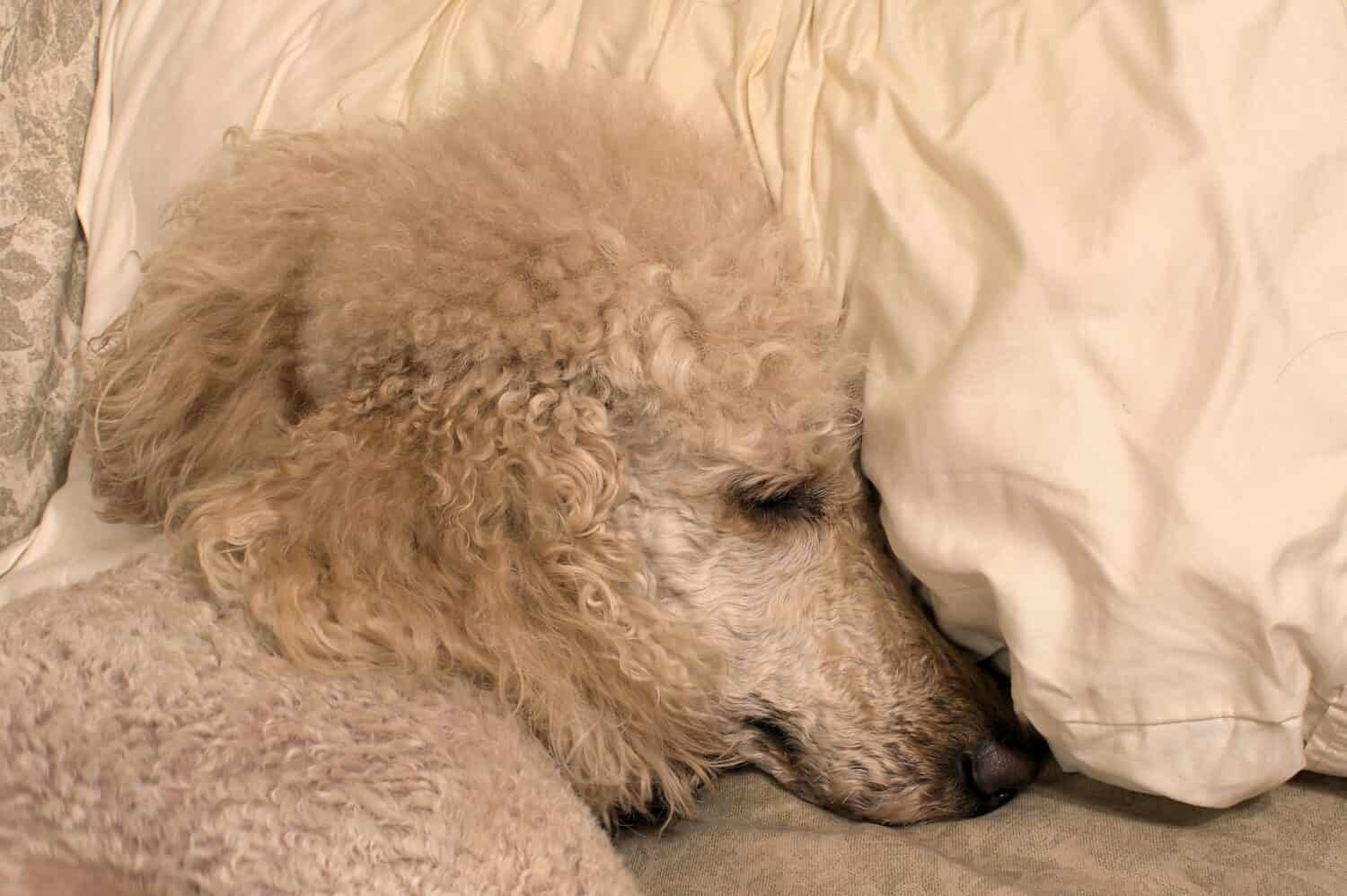Planning on adopting a poodle? If so, you may be wondering if your pup is at increased risk of certain medical conditions. While poodles are generally a sturdy and long-lived breed with relatively few health issues, purebreds are at risk of some inherited conditions.
In this guide, we’ll discuss seven of the most common poodle health issues, define them, list their most common signs and symptoms, describe how a vet typically diagnoses them, and present possible treatment options.
Read on to learn more.
Poodle Health Issues
If you’re adopting a puppy or adult poodle, it’s important to understand what health issues your pup may be genetically predisposed to developing. Unless you have information on your pup’s genetic history, it can be difficult to know what risks your pup may face. It’s also important to know that purebred poodles face a higher risk of developing genetic disorders than mixed-breed poodles.
Below, we’ll discuss seven of the most common health conditions that particularly afflict purebred poodles.

While poodles are generally considered a healthy breed, there are a few genetic conditions they are at an increased risk of developing.
©Baronb/Shutterstock.com
Sebaceous Adenitis
Poodles have sensitive skin and are known to develop a variety of skin conditions. The most serious skin condition affecting poodles is the inflammatory skin disease, sebaceous adenitis. This condition is a hereditary disease in which the sebaceous glands become chronically inflamed. Often, this condition leads to progressive hair loss. Standard poodles are the most at risk of developing this skin disease compared to miniature and toy varieties.
Signs and Symptoms
Signs and symptoms of sebaceous adenitis include the following:
- scaly and crusty skin
- excessive dandruff
- skin lesions
- irritate skin
- thinning hair
- musky-smelling coat
- itching

Irritated skin and thinning hair can be signs of sebaceous adenitis.
©9gifts/Shutterstock.com
Diagnosis
To diagnose this condition, your vet will likely perform a skin biopsy. They will also examine the skin and coat of your poodle to note any changes such as scaling and follicle plugging.
Possible Treatments
The primary treatment involves lifelong management and palliative care with topical shampoos, humectants, and oil soaks. Antibiotics and antifungal medications may be necessary to combat secondary infections caused by the skin’s compromised state.
Poodle Health Issues: Addison’s Disease
Also known as hypoadrenocorticism, Addison’s disease results from an insufficient production of adrenal hormones by the adrenal gland. These small, triangular-shaped glands are located on top of the kidneys. They are crucial regulatory glands and produce hormones that help regulate metabolism, immune responses, blood pressure, and other essential functions of the body. Standard poodles are most at risk of inheriting this disease.
Signs and Symptoms
Signs and symptoms of this disease in poodles include:
- lethargy
- loss of appetite
- gastro-intestinal distress
- weight loss
- increase thirst and urination
- tremors
- weakness
- bloody stool
- hair loss
- depression
Diagnosis
Your vet will order blood and urine tests to search for signs of Addison’s disease. These include electrolyte imbalances in sodium and potassium. I blood and urine tests are suggestive of Addison’s disease, your vet can order a definitive blood test called ACTH Stimulation. This test evaluates the adrenal gland’s response to a synthetic form of the ACTH hormone, which signals the adrenal gland to produce cortisol.
Possible Treatments
Treatment of Addison’s disease in poodles typically involves lifelong cortisol and aldosterone supplementation.
Hip Dysplasia
Hip dysplasia most commonly occurs in standard poodles, and less frequently, miniature poodles. With hip dysplasia, the ball and socket of the hip joint do not fit or develop properly. Instead of smoothly fitting and operating, they rub and grind with movement. This deformity of the hip occurs during joint growth.
Signs and Symptoms
Signs and symptoms of hip dysplasia include:
- limping in one or both of the back legs
- running with both legs moving in unison like a bunny hop
- difficulty getting up from lying or sitting
- a clicking sound originating from the hips upon movement
- weight shift to the front legs
- lethargy
- loss of muscle in the thigh
- stiffness and pain
- abnormal sitting position
- decreased range of motion
Diagnosis
Typically, vets will diagnose hip dysplasia in dogs through a hip radiograph performed under general anesthesia. Your vet may also perform palpating tests that may indicate hip dysplasia.
Possible Treatments
A range of treatments are available for treating and managing hip dysplasia. This includes supplements, anti-inflammatory medications, lifestyle modifications, physical therapy, and hip replacement surgery.

You may notice that your poodle with hip dysplasia has difficulty getting up from a lying or sitting position.
©nieriss/Shutterstock.com
Progressive Retinal Atrophy
Miniature and toy poodles are most at risk of inheriting the group of ocular degenerative diseases called progressive retinal atrophy (PRA). This group of diseases affects the photoreceptor cells responsible for phototransduction- the capturing of light and conversion into electrical signals. Specifically, poodles are most at risk of developing progressive rod-cone degeneration PRA (prcd-PRA) which is the late-onset, slowly progressing form of the disease. PRA is not a painful condition and typically progresses slowly. The disease usually initially presents as difficulty in seeing well at night. Eventually, the disease can progress into total blindness.
Signs and Symptoms
The signs and symptoms of PRA in miniature and toy poodles include the following:
- reluctance to move around in dark rooms or outside at night
- dilated pupils that constrict slowly in response to light
- apparent clumsiness and bumping into objects
- eyes that are more reflective at night
- the development of cataracts
- night blindness that can develop into total blindness
Diagnosis
Your vet may be able to diagnose PRA with an eye exam that focuses on the retina. Typically, both eyes are equally affected. Additional testing includes the use of electroretinography.
Possible Treatments
There is currently no cure for this degenerative eye disease. However, management is important to avoid injury and help your dog feel safer in their environment as they lose vision. Your vet may suggest the following steps:
- Add supplemental lighting to aid in night vision during the early stage of the disease.
- Avoid rearranging furniture so your dog can become used to navigating the home’s layout with decreased or total loss of vision.
- Use baby gates to limit access to unsafe areas of the house, such as stairs.
- Use gentle, rewarding positive reinforcement to develop excellent leash skills to help them safely navigate the world outside their home.
- Develop a set of verbal cues to help communicate with your dogs once they lose their vision. But make sure to develop this communication before vision loss when you can easily transition a hand cue to a verbal cue.

In its advanced stage, progressive retinal atrophy can cause your poodle to develop full cataracts.
©selvaco/Shutterstock.com
Poodle Health Issues: Epilepsy
The seizure disorder, epilepsy, is a prominent inherited health condition found in standard poodles. This condition is characterized by recurrent seizures, which are convulsions catalyzed by abnormal electrical bursts in the brain. There is typically an underlying cause of epilepsy, such as an imbalance of neurotransmitters, tumors, and brain disease. Epilepsy can be caused by genetic predisposition, environmental conditions, or both.
For poodles, the most common form of this condition in the standard poodle is idiopathic epilepsy. This form of epilepsy is genetic and not caused by any physical brain abnormality.
Signs and Symptoms
This condition typically presents in poodles between 1-5 years old. Signs and symptoms of epilepsy can include the following:
- collapsing
- jerking
- sudden rigidity of limbs
- muscle twitching
- loss of consciousness
- staring into space with no responsiveness
- tongue chewing and teeth gnashing
- mouth foaming and drooling
- urinary and bowel incontinence
- unawareness of surroundings
- sudden, intense fear
- vomiting
Diagnosis
Often, epilepsy can present in a myriad of ways, so it’s important to schedule a visit to your vet if you suspect this condition or your pup is showing neurological signs. Typically, your vet will diagnose canine epilepsy by ruling out other possible conditions. They will need to take an in-depth medical history, perform a thorough physical examination, and order a number of diagnostic tests, including blood and urine tests, and radiographs.
Possible Treatments
There is currently no cure for idiopathic epilepsy. However, a number of treatments are available and your poodle can live a relatively normal life with the right disease management. Often, the difficulty lies in finding the best treatment for your individual pup.
Currently, there are two drugs approved for the treatment of canine epilepsy: phenobarbital and imepitoin. Additional medications include levetiracetam, gabapentin, and zonisamide. All of these medications are used in an effort to reduce the severity and frequency of seizures. Generally, dogs need more than one medication to manage their epilepsy.
Poodle Health Issues: Hypothyroidism
Standard poodles are at an increased risk of hypothyroidism, a hormone imbalance caused by abnormalities of the thyroid gland. This is a progressive condition that leads to diminished thyroid function and insufficient thyroid hormone levels.
Signs and Symptoms
The signs and symptoms most commonly present in poodles with hypothyroidism include:
- weight gain without increased food intake
- lethargy and reluctance to exercise
- dull, dry coat
- excessive coat shedding
- coat thinning
- increased pigmentation of the skin
- cold intolerance
- depression
Diagnosis
Your vet can confirm a diagnosis of hypothyroidism by testing the serum thyroid hormone concentration levels. Currently, there are several thyroid tests your vet can order if they suspect hypothyroidism in your poodle. They are the T4, T3, FT4, TgAA, and TSH tests. Typically, your vet will order more than one of these tests to get an accurate diagnosis.
Possible Treatments
Currently, there is no cure for hypothyroidism. However, your poodle can live a happy, long life with the aid of daily administration of thyroid hormone replacement therapy. There are two drugs approved by the FDA for use in dogs affected by hypothyroidism: THYRO-TABS CANINE and ThyroKare. Both prescription drugs contain levothyroxine sodium as the active ingredient.

Lethargy can be a sign of hypothyroidism in standard poodles.
©Ray Geiger/Shutterstock.com
Poodle Health Issues: Patellar Luxation
Toy and miniature poodles are at an increased risk of developing patellar luxation, which describes the dislocation of the patella (kneecap). This small bone is held in place by ligaments and protects the front of the stifle joint. So, when it functions properly, as the knee moves, the patella should slide easily into a groove in the femur. However, with a luxating patella, the kneecap can slip in and out of its normal position in the groove.
Signs and Symptoms
The most common signs and symptoms that occur with patella luxation in toy and miniature poodles include:
- abnormal gait
- sudden skipping for a few steps followed by kicking or shaking of the affected limb
- apparent locking up of the knee joint
- limping
- yelping
- reluctance to move
- defensiveness if you apply pressure to the affected area
Diagnosis
Your vet may perform an orthopedic exam and order X-rays to diagnose this condition. The condition is diagnosed via a grading system of 1-4 based on severity. The grading system is as follows:
I: The patella (knee cap) can be luxated with specific manual pressure, but otherwise remains in the groove.
II: The patella spontaneously luxates and the dog typically displays a skipping lameness when the luxation occurs.
III: The patella is permanently luxated but can be manually placed back into the groove.
IV: The patella is permanently luxated and can not be manually replaced into the groove.
Possible Treatments
Treatment options depend upon the severity of the luxation. Typically, grade 1 and 2 patella luxations are treated with anti-inflammatory medicine, weight management, exercise restriction, joint supplements, and physical therapy. In contrast, for grade 3 and 4 luxations, your vet will likely recommend surgery. There are a few different types of surgery that can be performed to realign the knee cap into the patella groove. One type of surgery involves deepening the groove in the femur bone.

Toy and miniature poodles are most at risk for developing luxating patella.
©studio hoto/Shutterstock.com
The photo featured at the top of this post is © AntonMaltsev/Shutterstock.com
Ready to discover the top 10 cutest dog breeds in the entire world?
How about the fastest dogs, the largest dogs and those that are -- quite frankly -- just the kindest dogs on the planet? Each day, AZ Animals sends out lists just like this to our thousands of email subscribers. And the best part? It's FREE. Join today by entering your email below.
Thank you for reading! Have some feedback for us? Contact the AZ Animals editorial team.







